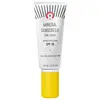What's inside
What's inside
 Key Ingredients
Key Ingredients

 Benefits
Benefits

 Concerns
Concerns

 Ingredients Side-by-side
Ingredients Side-by-side

Zinc Oxide 20%
Cosmetic ColorantWater
Skin ConditioningCaprylic/Capric Triglyceride
MaskingCoconut Alkanes
EmollientGlycerin
HumectantCetearyl Alcohol
EmollientCoco-Glucoside
CleansingAvena Sativa Kernel Meal
AbrasiveTocopherol
AntioxidantPersea Gratissima Oil
Skin ConditioningHelianthus Annuus Seed Oil
EmollientArachidyl Alcohol
EmollientBehenyl Alcohol
EmollientArachidyl Glucoside
EmulsifyingPolyhydroxystearic Acid
EmulsifyingBenzyl Alcohol
PerfumingXanthan Gum
EmulsifyingCoco-Caprylate/Caprate
EmollientZinc Oxide 20%, Water, Caprylic/Capric Triglyceride, Coconut Alkanes, Glycerin, Cetearyl Alcohol, Coco-Glucoside, Avena Sativa Kernel Meal, Tocopherol, Persea Gratissima Oil, Helianthus Annuus Seed Oil, Arachidyl Alcohol, Behenyl Alcohol, Arachidyl Glucoside, Polyhydroxystearic Acid, Benzyl Alcohol, Xanthan Gum, Coco-Caprylate/Caprate
Water
Skin ConditioningCoconut Alkanes
EmollientPropanediol
SolventTitanium Dioxide
Cosmetic ColorantSqualane
EmollientSorbitan Sesquiisostearate
EmulsifyingIsostearic Acid
CleansingPolysorbate 60
EmulsifyingTrehalose
HumectantGlycerin
HumectantAgar
MaskingSilica
AbrasiveMoringa Oleifera Seed Extract
Skin ConditioningSalicornia Herbacea Extract
Skin ConditioningMelilotus Officinalis Extract
AstringentTheobroma Cacao Seed Extract
AntioxidantCoco-Caprylate/Caprate
EmollientCaprylic/Capric Triglyceride
MaskingCaffeine
Skin ConditioningLauroyl Lysine
Skin ConditioningSuccinoglycan
Skin ConditioningAluminum Hydroxide
EmollientHydrogen Dimethicone
Citric Acid
BufferingDisodium Phosphate
BufferingAcetyl Tetrapeptide-5
HumectantButylene Glycol
HumectantPolyglyceryl-4 Laurate/Succinate
Cellulose Gum
Emulsion StabilisingMagnesium Chloride
Calcium Chloride
AstringentPotassium Chloride
Sodium Hyaluronate
HumectantMagnesium Stearate
Cosmetic ColorantPhenoxyethanol
PreservativeMica
Cosmetic ColorantCI 77491
Cosmetic ColorantCI 77492
Cosmetic ColorantCI 77499
Cosmetic ColorantCI 77891
Cosmetic ColorantWater, Coconut Alkanes, Propanediol, Titanium Dioxide, Squalane, Sorbitan Sesquiisostearate, Isostearic Acid, Polysorbate 60, Trehalose, Glycerin, Agar, Silica, Moringa Oleifera Seed Extract, Salicornia Herbacea Extract, Melilotus Officinalis Extract, Theobroma Cacao Seed Extract, Coco-Caprylate/Caprate, Caprylic/Capric Triglyceride, Caffeine, Lauroyl Lysine, Succinoglycan, Aluminum Hydroxide, Hydrogen Dimethicone, Citric Acid, Disodium Phosphate, Acetyl Tetrapeptide-5, Butylene Glycol, Polyglyceryl-4 Laurate/Succinate, Cellulose Gum, Magnesium Chloride, Calcium Chloride, Potassium Chloride, Sodium Hyaluronate, Magnesium Stearate, Phenoxyethanol, Mica, CI 77491, CI 77492, CI 77499, CI 77891
 Reviews
Reviews

Ingredients Explained
These ingredients are found in both products.
Ingredients higher up in an ingredient list are typically present in a larger amount.
This ingredient is an emollient, solvent, and texture enhancer. It is considered a skin-softener by helping the skin prevent moisture loss.
It helps thicken a product's formula and makes it easier to spread by dissolving clumping compounds.
Caprylic Triglyceride is made by combining glycerin with coconut oil, forming a clear liquid.
While there is an assumption Caprylic Triglyceride can clog pores due to it being derived from coconut oil, there is no research supporting this.
Learn more about Caprylic/Capric TriglycerideCoco-Caprylate/Caprate is created from fatty coconut alcohol, caprylic acid, and capric acid.
It is a lightweight emollient. Emollients create a thin barrier on the skin to trap moisture in. This helps keep your skin hydrated and soft.
Once applied, Coco-Caprylate/Caprate is absorbed quickly and leaves a silky feel.
Coco-Caprylate/Caprate may not be fungal acne safe.
Learn more about Coco-Caprylate/CaprateCoconut Alkanes is created from the fatty-acids of coconut oil. It is volatile, meaning it evaporates from the skin.
This ingredient is an emollient and solvent. As an emollient, it helps keep skin soft and hydrated. Solvents help distribute and mix other ingredients. This ensures a more even consistency.
Coconut Alkanes may not be fungal-acne safe.
Learn more about Coconut AlkanesGlycerin is already naturally found in your skin. It helps moisturize and protect your skin.
A study from 2016 found glycerin to be more effective as a humectant than AHAs and hyaluronic acid.
As a humectant, it helps the skin stay hydrated by pulling moisture to your skin. The low molecular weight of glycerin allows it to pull moisture into the deeper layers of your skin.
Hydrated skin improves your skin barrier; Your skin barrier helps protect against irritants and bacteria.
Glycerin has also been found to have antimicrobial and antiviral properties. Due to these properties, glycerin is often used in wound and burn treatments.
In cosmetics, glycerin is usually derived from plants such as soybean or palm. However, it can also be sourced from animals, such as tallow or animal fat.
This ingredient is organic, colorless, odorless, and non-toxic.
Glycerin is the name for this ingredient in American English. British English uses Glycerol/Glycerine.
Learn more about GlycerinWater. It's the most common cosmetic ingredient of all. You'll usually see it at the top of ingredient lists, meaning that it makes up the largest part of the product.
So why is it so popular? Water most often acts as a solvent - this means that it helps dissolve other ingredients into the formulation.
You'll also recognize water as that liquid we all need to stay alive. If you see this, drink a glass of water. Stay hydrated!
Learn more about Water